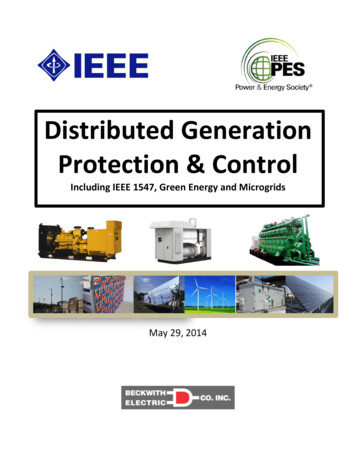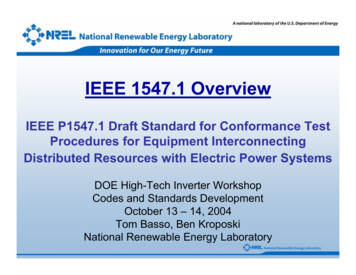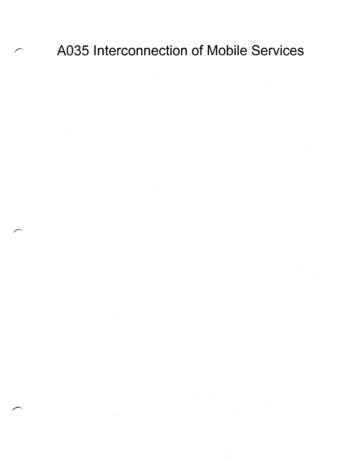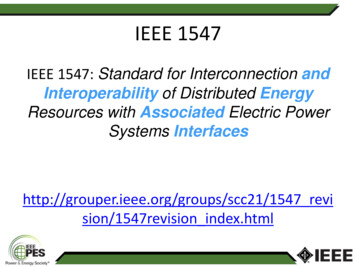
Transcription
IEEE P2800—Draft IEEE InterconnectionStandard for Large-Scale Solar, Wind, andEnergy Storage Plants (IBRs)Jens C. Boemer, WG Chair*Bob Cummings, Babak Enayati, Ross Guttromson,Mahesh Morjaria, Manish Patel, Chenhui Niu, Vice-chairsDiwakar Tewari, Secretary & TreasurerFebruary 17, 2021 – IEEE SA Ballot UpdateGeneral Information for the Interested Public - https://sagroups.ieee.org/2800/*Also Chair of the sponsoring ED&PG Wind and Solar Plant Interconnection Working Group (Link to Website)IBR: Inverter Based ResourcesThis effort is, in part, funded by the Alliance forSustainable Energy, LLC, Managing and OperatingContractor for the National Renewable EnergyLaboratory (NREL) for the U.S. Department ofEnergy (DOE) under the DOE project “AcceleratingSystems Integration Standards II (ACCEL II)” underthe grid performance and reliability topic areafocusing on the distribution grid.
Outline – Joint SEIA-ACP Webinar – February 17, 2021 Welcome by host organizations – 2 min.– Evelyn Butler, SEIA– Michele Mihelic, American Clean Power Association Presentation by Mahesh Morjaria (WG Vice-Chair) – 35 min.– IEEE P2800: purpose, scope, schedule– High-level review of selected draft requirements– Potential adoption of IEEE 2800 in North America Comments by hosting organizations – 3 min. Q&A - 15 min. How to join the ballot group? (Step-by-Step Instructions) – 5 min.– Diwakar Tewari, WG Secretary & Treasurer2
Summary of IEEE P2800 Draft Standard The draft standard harmonizes InterconnectionRequirements for Large Solar, Wind and Storage Plants It is a consensus-based draft developed by over 175Working Group participants from utilities, systemoperators, transmission planners, & OEMs over 2 years You can further influence the draft standard by(1) participating in the IEEE Ballot Pool (by March 3, 2021)(2) supporting adoption of the standard3
Approximately 300 Interested Parties and 175 WG Members 99%ApprovalBroadCollaboration &Coordination4
Status Quo -- Solar, Wind & Storage Interconnection Requirements Diverse & different requirements acrossvarious jurisdictions requires more effort and time to address Inverter-based resources (IBR) are differentfrom synchronous generators higher (and sometimes lower) capability Requirements may not be balancedSource: https://www.natf.net/ some too stringent & not taking advantage of newcapability5
IEEE P2800 Objective: Filling Gaps in North American Interconnection StandardsTest & Verification &Model ValidationNARUC / State PUCs?FERC / ution(for DER) FERC Orders NERC Reliability Standards& Guidelines Not availableIEEEP2800 IEEE Std 1547-2018 NERC compliancemonitoring &enforcement Not available IEEE 1547.1-2020 Ul 1741 (SB) IEEE ICAPIEEEP2800.1and/or .x When adopted by the appropriate authority (e.g., TransmissionOwners, NERC, FERC), IEEE standards become mandatoryDER: DistributedEnergy Resources6
IEEE Standards Classification and Consensus BuildingIEEE1547.1IEEE 1547Standardsdocumentsspecifying mandatoryrequirements (shall)IEEEP2800Recommended Practicesdocuments in which procedures andpositions preferred by the IEEE arepresented uments that furnish information – e.g., provide alternativeapproaches for good practice, suggestions stated but no clear-cutrecommendations are made (may)IEEEP2800.xIEEEP2800.17
What to expect from IEEE P2800? Provides Value– widely-accepted, unified technical minimum requirements for IBR– simplification and speed-up of technical interconnection negotiations– flexibility for IBR plant developers not an equipment design standard Specifies– performance and functional capabilities and not utilization & services– functional default settings and ranges of available settings– performance monitoring and model validation– type of tests, plant-level evaluations, and other verifications means, butnot detailed procedures ( IEEE P2800.1 and/or P2800.x) Scope– Limited to all transmission and sub-transmission connected, large-scalewind, solar, energy storage and HVDC-VSC8
Examples for Inverter-Bases Resources (IBR) PlantsinverterDCPVPlantACin ePlantESSbidirectionalconverterRPAPOITSDefault Reference Point ofApplicability (RPA) isPoint of Measurement (POM)POI: Point of InterconnectionTS: Transmission System
Example hybrid IBR plant, ac-coupledin scopeinverterDCACRPAPVPOITSHybridPlantDefault Reference Point ofApplicability (RPA) isPoint of Measurement (POM)ACWTGsDCESSbidirectionalconverterPOI: Point of InterconnectionTS: Transmission System
Example hybrid plant: operated as a single resourcein scopenon-IBRRPAACconventionalgenerator or nonIBR ESSACRPAPOITSACIBR plant RPADefault Reference Point ofApplicability (RPA) isPoint of Measurement (POM)WTGsDCESSbidirectionalconverterhybrid IBR plantPOI: Point of InterconnectionTS: Transmission System
IEEE P2800 Technical Minimum Capability RequirementsTS ownercan requireadditionalcapabilityCapabilityRequired in eControlsPrioritizationQ for voltagecontrol atzero rolresponsesApplicabilityto DiverseIBR PlantsReactivePower– alanceRapid ity nBalancedCurrentInjectionVoltage RidethroughModeling &Validation,MeasurementData, andPerformanceMonitoringProcess andcriteria formodelvalidationHigh FidelityPerformanceMonitoringTests ringPlant-levelEvaluation &ModelingCommissioningTestsFrequency &Phase-jumpRide-throughCoordinationOf Protection 99%ApprovalValidatedModelsType tests EPRIUtilization of these capabilities is outside the purview of P280012
Voltage And Reactive Power Control ModesThe IBR plant shall provide the following mutually exclusive modes of reactive powercontrol functions: RPA voltage control mode Power factor control mode Reactive power set point control modeRPA voltage control Closed-loop automatic voltage control mode to regulate the voltage at the RPA Stable response & any oscillations shall be positively damped ( 0.3 damping ratio) Capable of reactive power droop to ensure a stable and coordinated responseParameterReaction TimeMaximum StepResponse TimeDampingPerformance Target 200 msNotesAs Required by TS Operatorrange between 1 s and 30 sDamping ratio of 0.3 or better13
Reactive power (Q) capability at RPA vs Active Power0.3287: Equivalent to 0.95 PFRPA: Reference Point of Application14
Reactive power (Q) capability at RPA vs Active PowerICAR: IBR continuous absorption rating15
Reactive power (Q) capability at RPA Vs VoltageICR: Interconnection Continuous Rating16
Voltage Ride-Through Capability120%110%Wind Based ResourcesMandatory Operation or May TripMandatoryOperation(except for 500kV IC)Continuous Operation - 30 minutes100%Continuous Operation – Infinite timeVoltage(p.u.) at POM80%Mandatory OperationMandatory Operation or May Cumulative Time (Seconds)Mandatory Operation orMay TripMandatory OperationContinuous OperationMandatory OperationMandatory OperationMandatory OperationMandatory OperationPermissive OperationV 1.10V 1.05V 0.90V 0.70V 0.50V 0.25V 0.10Minimum ridethrough time (s)(design rating mode/responseV 1.2060%5.070%0.16Voltage (Percentage)90%17
Voltage Ride-Through PerformanceNo specification ofcurrent magnitudeThe 1-cycle time required for DFT (to derive phasorquantities) is included in specified response/settling time.Type III WTGsAll other IBR UnitsNA1 2.5 cycles 6 cycles 4 cyclesMax of ( 10% of requiredchange or 2.5% of IBR unitmaximum current)Max of ( 10% of requiredchange or 2.5% of IBR unitmaximum current)Step ResponseTimeSettling TimeSettling BandNote 1: Initial response is driven bymachine characteristics, & not thecontrol system.Slower response/settling time ispermitted with mutual agreementbetween TS owner and IBR owner.18
Frequency Ride-Through CapabilityFrequencyRange (Hz)% fromfnomMinimum Time (s)Design CriteriaOperationf1 , f4 3, -5299.0 (t1)Mandatoryf2 , f3 2, -2 Continuous19
Primary Frequency Response (PFR) of an IBR at RPAPminFrequency (f)ffnom The PFR capability shall meet the performance requirement as shown Continuous and mandatory operation region for frequency & voltage.ExampleOver-FrequencyPActivePower (P)dbOFdbOFfPpreExampleUnder-Frequency0PpreICR(or ISR)PICR: Interconnection Continuous Rating20
Clause 12 (Test and Verification) FrameworkWhere’s thereference point ofapplicability (RPA)?What’s thto VerifiorcationPoCRideThroughValidatedUnit Model(s)Type testsRequired path toverificationCategory of test andverification ioningmodel validationPostcommissioningmonitoringPeriodictest est orverification(IBR units) (Design & ning Test21
Anticipated Timeline to PublicationMay 2019Jan 2019 Dec 2020Q1/2021Q2/2021Q3/2021Q4/2021P2800Kick-OffWG Draftingin Submit toRevComPublicationP2800.1Kick-Off WG Draftingin ParallelSubGroups RelatedactivitiesIEEE 1547.1is publishedNERC IRPWGGuidelinesPossibleNERC SARsIEEE P2882IEEE P2800.x2022InitialSponsorBallotAs soon as IEEE P2800 has been successfully balloted,the drafting of conformance procedures will commence in projectslike IEEE P2800.1, P2800.x, and P2882.22
IEEE SA Ballot – SA ballot groupDIWAKAR TEWARIP2800 WG SECRETARY & TREASURERPresentation Date Feb 18th, 2021
IEEE-SA Sponsor Ballot & Public Review IEEE SA Ballot Group invitation was sent to 2,500subject matter experts within IEEE societies andtheir committees Goal is to form a balanced ballot group by March 3,2021, with no one stakeholder group havingdominance Follow instructions available on the P2800 website athttps://sagroups.ieee.org/2800/members/General information on the (public) IEEE-SA ballot isavailable lestone: SA Initial Ballot March 4, 2021* (30 days for SA ballot, WG/CRG resolves Public Reviewcomments, 60 days for public review)Recirculation 1June 2021* (10 days comment resolution)Recirculation 2July 2021* (10 days comment resolution)Recirculation n-thAug 2021* (10 days comment resolution)Milestone: Submission toRevComMilestone: PublicationAug 13 / Sep 10 / Oct 18, 2021*Consensus 75% Quorum 75% Approval December 2021** tentative datesWG Chair’s goal is 90%!24
Comments by hostingorganizationsEVELYN BUTLER, SEIAMICHELE MIHELIC, AMERICAN CLEAN POWER ASSOCIATIONFebruary 17, 2021 – IEEE SA Ballot UpdateGeneral Information for the Interested Public - https://sagroups.ieee.org/2800/*Also Chair of the sponsoring ED&PG Wind and Solar Plant Interconnection Working Group (Link to Website)This effort is, in part, funded by the Alliance forSustainable Energy, LLC, Managing and OperatingContractor for the National Renewable EnergyLaboratory (NREL) for the U.S. Department ofEnergy (DOE) under the DOE project “AcceleratingSystems Integration Standards II (ACCEL II)” underthe grid performance and reliability topic areafocusing on the distribution grid.
Standards Development LifecycleThis presentation provides an overview of Stage 4 of the standards developmentlifecycle –Balloting the Standard26
AGENDA1.2.3.4.Invitation Process step by StepBalloting Flow ChartPublic ReviewSA Ballot - Response & approval rate27
MyProject Sign in MyProject IEEE SA Membership28
Manage Profile and InterestIf this is the first time you have signed in, you will be asked to add personal and professional infoand preferences and to save the profile.29
Menu – Click on Invitations/BallotsClick on the Menu bottom on the right, select Invitation/Ballots30
Invitations/Ballot – All InvitationsClick on the Open Invitations TAB, then click on the button that shows All Invitations to see allopen invitations.If you have added interest for this project, it will show up in the my Invitations listing31
Join the BALLOT GROUPClick on Join the Ballot button on the right32
Add your affiliationAdd your affiliation, you can type it in or select it, next click on the select Classification button33
AFFILIATION Confirmation SCREENConfirm your affiliation by clicking ok34
SELECT classificationSelect a voter classification that best suits your interest in this ballot.35
Submit Your selection For Voter ClassificationScroll down the page the list and click on the submit button36
Confirmation of joining SA BallotA confirmation screen pops up to confirms showing you have joined the Ballot groupP2800P280037
Confirmation on JOINING Ballot GroupThe Check indicates you have joined the ballot group successfully.When the Ballot is initiated and once the invitation period closes, you will be informed to ballot on thedocument. Invitation is open for 30 days.38
Balloting Flow chartPlease see section 6.10 of the myProject user guide for steps on how to Ballot39
Public Review Process OverviewA 60 day Public Review period begins automatically with the opening of the SA BallotThe IEEE SA Public Review process provides an opportunity for any interested party to submit comments on anyeligible initial ballot draft, and obtain responses from the IEEE Working Group.All comments received from the Public Review period shall be considered and responded to. Public Reviewcomments do not have votes associated with them. Consensus is not based on Public Review comments Working Group/Comment Resolution Group will identify in their response if they have determined that theywill make a change in the draft If responses identify a change to the draft, the Public Review commenter can request a revised draft Each public review commenter receives only their responses As normally required, changes to the draft must be recirculated in a SA Ballot recirculation All Public Review comments and responses shall be submitted to RevCom40
IEEE SA Ballot consensus: Response & approval rateIEEE SA Ballot Consensus is achieved when: At least 75% of the ballot group voted (Response rate) The number of Approve votes is 75% or more of the total Approve and Do Not Approve (with Comments) votes.(Approval Rate) Fewer than 30% of the ballot group voted AbstainResponse Rate: If the response rate is not met: The ballot can be extended by the Program Manager (PM) WG Officers and PM can work together to reach out to those that have not responded The response rate must be met in order to continue with the balloting process.Approval Rate: If the approval rate is not met, the entire draft is open for comments on the next ballot (recirculation). During a recirculation ballot, SA balloting group members shall have an opportunity to cast votes or change their previously castvotes.41
SA Ballot Next Steps - Recirculation OverviewWhen is a recirculation ballot required? All unresolved Do Not Approve votes with comments shall be recirculated to the Standards Associationballoting group. All substantive changes made since the last ballot of the proposed standard shall be identified andrecirculated to the Standards Association balloting group. If there are significant changes made to the draftyou may consider opening: The entire draft for comments on the next ballot recirculationThe recirculation for a longer period of timeRecirculation ballot(s): Minimum of 10 days During a recirculation ballot, SA balloting group members shall have an opportunity to cast votes or changetheir previously cast votes Once the proposed standard has achieved 75% approval, comments in recirculation ballot(s) shall be basedon: Only on the changed portions of the draft Portions affected by the changes Portions subject to unresolved comments associated with Do Not Approve votes.42
SA Ballot – Comment Resolution Guidelines The Comment Resolution Group will review and consider all comments that are received by the close of theballot. This includes comments received outside of the myProject system and mandatory coordinationcomments. Evidence of Consideration Comments that advocate changes in the proposed standard, whether technical or editorial, may be accepted,revised, or rejected. Until the proposed standard has achieved 75% approval, comments can be based on any portion of the proposedstandard Comments not based on the proposed standard may be rejected and deemed out-of-scope of the standardsballoting process by the Standards Committee.Comments received by the WG after the close of the ballot Shall be acknowledged and may be considered The Standards Committee shall acknowledge the receipt of these late comments Take action as the Standards Committee deems appropriate. For more information, see the IEEE SASB Operations Manual Clause 5.4.3.3 -Comments in the ballot43
Additional ResourcesThe SA Balloting g-standard/balloting.htmlRevCom Ballot and Comment Resolution Process elines.pdfRevCom Comment Resolution Preparation nt Resolution Preparation Guidelines.pdfIEEE SA Standards Working Group Chair Fundamentals Course, Module 10 “Balloting Your Standard”44
Questions?Malia ZamanSenior Program ManagerIEEE Standards AssociationPhone: 732 850 6608Email: m.zaman@ieee.orgwww.standards.ieee.org45
Feb 17, 2021 · IEEE P2800 IEEE Std 1547-2018 IEEE P2800.1 and/or .x. When adopted by the appropriate authority (e.g., Transmission Owners, NERC, FERC), IEEE standards become mandatory. Transmission Sub-Transmission IEEE 1547.1-2020 Ul 1741 (SB) IEEE ICAP










